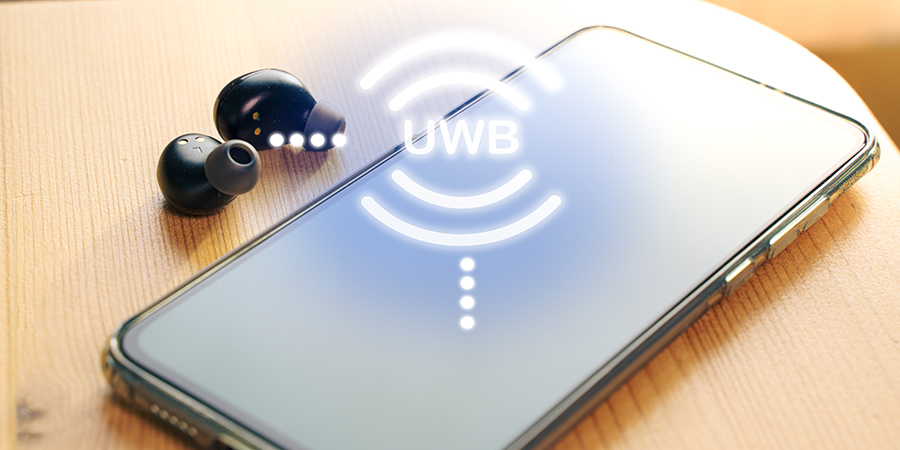Ultra-Wideband (UWB) technology has been around for several years but its adoption by popular smartphone makers has put the high-spectrum technology at the forefront.
We have all benefited from using Google maps while driving out in the unknown outdoors, thanks to the satellite tracking (GPS) technology that makes it possible. However, in today’s increasingly connected world that we live in, the need for indoor tracking devices to provide accurate geolocalisation of objects or people is undoubtedly generating global interest.
Responding to this growing demand and its specific requirements, manufacturers of the Industrial Internet of Things (IIoT) sector are developing more effective indoor positioning systems (IPS) for accuracy, cost-effectiveness, scalability, reliability and security. One such solution that is gaining steady recognition is the Ultra-Wideband (UWB) technology with its spatial awareness capabilities.
UWB technology provides both high bandwidth and short-range data transfer between electronic devices. This high-frequency spectrum technology, developed by the US military, was initially used for radar imaging. UWB can reach speeds of up to 100 megabits per second (Mbps), and provides the highest pulse shaping rates to enable accurate localization through a combination of UWB pulse frequency and its flight time triangulation information (TOA) device.
Another factor that makes it the tech of choice for indoor localization is its zero-interfere with radio transmissions to ensure interoperability with other devices and technologies.
The popularity of UWB climbed a notch up in 2019 when smartphone maker Apple used the technology in the iPhone 11 series via its U1 chip that allowed users to use the AirDrop feature to point their iPhone in the direction of the other U1 chip embedded device to transfer files. After which other phone makers such as Samsung and Xiaomi have followed suit.
What’s so special about UWB?
One may wonder even other wireless technology such as Bluetooth can help in figuring out where something is located over short distances, so why do we need UWB? It turns out UWB is superior to Bluetooth in many ways:
Depending on how it is implemented, it can locate objects with a margin of as little as 5 millimeters as opposed to the 1 meter that Bluetooth allows. UWB can also update its position 10 times per second and UWB operates on a relatively low frequency with data transfer rates at low cost and low power.
For example, UWB is more secure than Bluetooth because of the support of time of flight which means UWB can be used to detect the proximity of someone attempting to send a signal. Think of a smart door lock that will only unlock when it senses that the homeowner's phone is right in front of it or a car’s locking system that can beat relay attacks due to its jamming resistance capability.
It is ideal for devices in the home and business environments (laptops, mobile phones, TVs, DVDs, memory sticks, digital cameras, MP3 players) to be integrated for network wirelessly.
What is it going to be used for?
The global real-time location systems (RTLS) market is expected to touch $11.47 billion by 2026 growing at a CAGR of 22.8% from 2019 to 2026, according to reports.
UWB support can be used in positioning, geo-location, localization (accurate positioning and high multipath environments), radar and sensor applications (vehicular, marine, GPR, sense-through-the-wall (STTW) and surveillance systems), communications (high multipath environments, short-range communications, and high data rates) and roles of UWB in medical applications, medical monitoring, and medical imaging.
In other instances, US consumer electronics company Tile is coming up with a new tracker that will allow users to use the augmented reality (AR) feature in its app to open their camera to view an item’s precise location.
Carmaker BMW recently announced plans to roll out Digital Key Plus feature whereby drivers can unlock and start their car without taking their iPhone out of their pocket or bag. The iPhone will need to be in proximity of the vehicle to unlock and start it.
Future of UWB
According to global tech market advisory firm, ABI Research, there will be 300 million UWB device shipments in 2021.
Factors such as rapid adoption of business analytics solutions, an increase in smartphone use, and the popularity of ultra-wideband technology are driving the growth of the market. However, lack of proper infrastructure is the biggest hindrance to its adoption. There is ample scope for antennae installation at project sites involving big capital investment.
Indoor 5G ultra-wideband installations within business customer facilities are crucial in the process to deliver a commercial private 5G solution for growth in business operations, manufacturing, and customer experiences across a variety of industries.
Although it all sounds great, there’s a lot of work left to be done by developers writing software for UWB and other gadgets to incorporate compatible hardware. As of now UWB is enabled on Apple devices but is not able for developers. UWB access to the developer community is expected to take some time. UWB also faces threats from enhanced location accuracy with the new Bluetooth Low Energy 5.1 standard that will need less power usage and has a longer battery life.
All in all, UWB offers a unique model to wireless communications compared to traditional narrowband systems. The capability of these wide bandwidth wireless systems to produce low cost, low energy, short-range, high capacity wireless communications links will likely have plenty of takers in the coming days.











